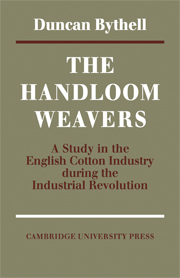Book contents
- Frontmatter
- Contents
- Preface
- Introduction
- Map of the weaving towns and villages of north-east Lancashire in 1821
- 1 Problems and sources
- 2 The organization of the industry
- 3 The labour force
- 4 The coming of the powerloom
- 5 Wages: (I) The piece-rate
- 6 Wages: (II) Earnings and the standard of living
- 7 Public opinion and the handloom weavers
- 8 Organized industrial action among the cotton handloom weavers
- 9 The weavers and radical politics
- 10 The problem of poverty
- 11 Displacement and disappearance
- Appendix 1 Some piece-rate series
- Appendix 2 The piece-rate and the price of food
- Appendix 3 G. H. Wood's estimates of average weekly earnings
- Bibliography
- Index
11 - Displacement and disappearance
Published online by Cambridge University Press: 07 October 2011
- Frontmatter
- Contents
- Preface
- Introduction
- Map of the weaving towns and villages of north-east Lancashire in 1821
- 1 Problems and sources
- 2 The organization of the industry
- 3 The labour force
- 4 The coming of the powerloom
- 5 Wages: (I) The piece-rate
- 6 Wages: (II) Earnings and the standard of living
- 7 Public opinion and the handloom weavers
- 8 Organized industrial action among the cotton handloom weavers
- 9 The weavers and radical politics
- 10 The problem of poverty
- 11 Displacement and disappearance
- Appendix 1 Some piece-rate series
- Appendix 2 The piece-rate and the price of food
- Appendix 3 G. H. Wood's estimates of average weekly earnings
- Bibliography
- Index
Summary
One last problem remains. The cotton handloom weavers failed to keep their trade alive: from being probably the most numerous single group of workers in manufacturing industry in the 1820s they dwindled within thirty years into a picturesque anachronism, encountered only in small numbers and in odd localities. How quickly had this change been brought about, and where had the weavers gone? Largely because of the thinness of the evidence, there has been no adequate examination of these two problems. Yet even if it is possible to offer only general suggestions on this topic, it must be clear from the outset that some of the more facile explanations will not suffice. Mr E. P. Thompson, for example, has suggested that the majority of the handloom weavers left the trade in the 1830s simply because they died off, either of old age, or prematurely as a consequence of their reduced economic circumstances. There is, however, a great deal of evidence to show that, in fact, many of the weavers were sufficiently wise and realistic to heed the lessons of ‘political economy’, and sought more secure and remunerative employment elsewhere.
How successful were they in finding new jobs? There has always been a school of thought among historians which suggested that the weavers' misery was protracted unnecessarily because of their blindness to the economic facts of life, which made them ‘reluctant’ to take up the most readily available alternative work in the ever-expanding cotton factories.
- Type
- Chapter
- Information
- The Handloom Weavers , pp. 251 - 272Publisher: Cambridge University PressPrint publication year: 1969

